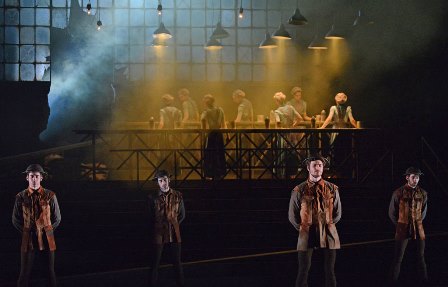5 April 2014 (matinee), Barbican Theatre, London
Tamara Rojo’s recent mixed bill program, Lest we forget for English National Ballet, was created to commemorate the centenary of the outbreak of World War I in 1914. Having spent the ten days preceding my viewing of Lest we forget researching Ballet Rambert’s wartime experiences as a touring company during World War II, I was very curious to see what this program had to offer. Unfortunately I had to leave without seeing the full program (I didn’t want to miss my plane back to Australia!). However I was particularly pleased that I didn’t miss No Man’s Land, a commissioned ballet from Liam Scarlett, whose work I have never seen before, and whose Serpent will be seen in Sydney in May as part of the program being brought to Australia by BalletBoyz.

Scarlett was moved to create a work that showed how men and women were involved in the war effort and how they related to each other and amongst themselves. A multilevel set (design Jon Bausor) had the women on a raised platform at the back of the stage where they carried out their work in factories making ammunition, explosives and other items. The men occupied the front of stage, the trenches of war, and a ramp linked the two areas. Evocatively lit by Paul Keogan, the work took place in what seemed like the shadow of the past. Although there was a simple storyline of men leaving the women behind as they went off to fight, with only six of the seven returning at the end, the lighting made it seem as though we were watching not a story but a series of hazy vignettes from the past.
I found the choreography, created on seven couples, sometimes complex and acrobatic with the highlight the concluding pas de deux between Tamara Rojo and Esteban Berlanga as her ghostly partner, the man who did not return. Rojo’s body language before the pas de deux even began told it all—the sorrow, the loss, the longing. The three pas de deux that took place in the battlefield area were also powerful. I especially admired that between Ksenia Ovsyanick and Laurent Liotardo with its anguished, flying bodies.
But some of the most hypnotic material was really very simple. The touch of a hand on the face as the men left for the battlefield; the women wrapping their arms over the shoulders of the men, simulating the straps of a burdensome backpack; the toss of dust in the air by the women as they worked at their factory benches, for example. Strong imagery works wonders especially when it contrasts with more complex movements as the men face their battles. Music was an arranged and orchestrated selection of material from Liszt’s Harmonies poétiques et réligieuses.
Second Breath from Russell Maliphant relied on the visual power of strong and ever-changing groupings of the cast of 20. The work was danced to a background score by Andy Cowton drawn from material in the Imperial War Museum. It was basically an audio compilation of voices reciting the numbers of the dead. Quite chilling material to juxtapose against those beautiful, spiralling groups of bodies. The other work that I was able to see on the program was something of an oddity, unrelated it seemed to me to the theme of war—a restaging of George Williamson’s reinvention of Firebird. Unfortunately I had to miss Akram Khan’s Dust,
A persistent thought occupied my mind as I thought about the program. I kept wondering if the Australian Ballet had considered bringing back Stephen Baynes’ 1914, with its original score by Graeme Koehne and those outstanding designs by Anna French? Although it seems not to have been a favourite with many, I really liked it and what a cast it had with Steven Heathcote and Lisa Bolte in the leading roles. I would love to see it again, perhaps with revisions that Baynes might like to make? It might have been more fitting for the 2014 Australian Ballet season than, say, Manon (of which more later).
Michelle Potter, 15 April 2014
Michelle, I saw this programme on April 9th. It was a terrible shame that you missed Akram Khan’s Dust as this incredible piece blew the rest of the evening out of the window. Not to diminish the other ballets as they too had wonderful moments – especially the Firebird which cleverly showcased our most exciting British ballerina in the making Lauretta Summerscales. I agree with you though, as I cannot see the connection this piece had to the evening. Khan’s Dust brought home the power and sheer emotional punch needed in an evening paying homage to the bravery and suffering inflicted upon the soldiers of WW1. Anyone who hasn’t seen this should rush along to the Barbican, if not already too late.
Suzanne, I absolutely agree about Lauretta Summerscales. I saw her as the Firebird and was stunned by her power and presence and her wonderful technical skills. I hope I have an opportunity to see more of her in the not too distant future. I should have mentioned her in the post but I really just wanted to leave the work without what would have been nothing more than an occasional comment. Too many issues there I thought. I too am sorry to have missed Dust. I guess the Scarlett work appealed in particular though because I had been looking in depth at the hostel tours the Ballet Rambert made during the WW II period and No Man’s Land to me put those performances into a beautiful dance perspective.